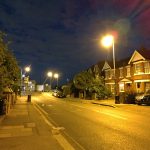Camera
On paper, the dual-camera system used with the ZenFone 5 is almost identical to that of the ZenFone 4. The 12MP primary sensor has supposedly been upgraded, from the Sony IMX362 to the IMX363, but the sensor size is the same at 1/2.55″ and pixel size is the same at 1.4µm. The lens aperture of f/1.8 is also the same. The difference between the two seems to be the lens FOV – ASUS says the ZenFone 5 has a 24mm equivalent focal length, while the ZenFone 4 has a 25mm equivalent focal length. Other than that, the primary cameras seem identical.
The secondary sensor takes 8MP photos and is a 120° wide-angle camera – ASUS says it is the equivalent of a 12mm lens on a full-frame (35mm) sensor. There is less information available about this secondary camera, but the on-paper spec is again unchanged.
We break the camera analysis into three sections – out of the box image quality using the primary camera, a comparison of the primary and wide-angle cameras, and a look at the camera's HDR processing.
Auto image quality
Note: if the above images are not displaying properly, you may need to disable your ad block software as they are known to interfere with our display code.
Starting with a look at general, out of the box image quality using the primary 12MP sensor. In a nutshell, I think it is capable of taking pretty decent photos.
For one, the colours are nice and punchy, while there is a good amount of detail to each shot (though that does depend on the amount of light available – but more on that later). I would suggest the images can look a touch over-sharpened, but this seems to be a modern trend that more and more manufacturers are adopting, so maybe I'm in the minority which likes a more natural-looking image.
On the whole, though, I am pretty pleased with some of the photos presented above. You will notice, however, that the sharpest photos were taken with lots of light available – low-light shots quickly lose detail and look rather grainy, which is a shame.
The other thing to touch on is the AI scene detection. The ZenFone 5 can recognise 16 different objects/scenes – including people, food, cats, dogs, and so on – and then it automatically optimises ‘the camera settings for almost any kind of subject'. In all honesty, I couldn't tell what was being optimised. The scene detection worked fine – I would point the phone at my dog, and a dog icon came up in a second or two, no problem. The issue is, I simply can't tell what the camera is actually changing once it has detected the scene or object.
With the Huawei P20 Pro, for instance, there is a noticeable change in what the photo looks like after a scene has been detected – point the phone at the sky, and you will notice the sky looks bluer. With the ZenFone 5, it's all well and good having scene detection – but since you can't really tell what is actually being changed, it feels like it is there just for the sake of it.
Standard vs wide-angle lenses
Unlike most other photos with a secondary camera, the ZenFone 5 has a wide-angle lens rather than a telephoto. It is only 8MP, so images aren't as big as with the primary camera, but you do get a significantly enhanced FOV.
It can look really good, too, depending on what you are photographing. Wide architectural shots can look much better than the standard lens, as you can fit so much more in frame. It's also a great tool if you just physically cannot move back any further to try and get everything in shot.
Because it is so wide, you do get some barrel distortion – that fish-eye effect – particularly towards the edges of the frame. This makes straight lines look rather curvy, which could be a pain if you are trying to get everything perfectly symmetrical. On the flip-side, you can actually use it as a bit of an artistic tool to create some funky images. I would just say photos of people don't look too good with the wide-angle lens due to that distortion.
The wide-angle lens also struggles in lower-light situations – you can see there is less detail in the photos compared to the primary camera, even in bright daylight, so when you go inside or it gets to night time, images do look rather grainy.
On the whole, though, I do like the inclusion of the wide-angle lens. It is probably best to use it with discretion – it won't look good all the time, particularly in low light – but when you get it right, it can produce a photo that very few other phones can manage.
HDR
The last feature to talk about is the ZenFone 5's HDR processing. By default, the camera app uses ‘HDR Auto' so it automatically creates a HDR shot if it thinks the photo needs it. You can, however, turn HDR off entirely, or keep it on all the time.
From the example shots above, I think it becomes pretty clear than having HDR on will create a better final photo 9 times out of 10. The camera's dynamic range with HDR off is frankly terrible, but when you enable HDR it manages to pull back so much detail and colour from previously blown-out areas of each photo.
It's not perfect – it can make the photos look a bit flat, or sometimes a little artificial – but compared to what the photo would look like if the HDR option was not there, I would take the HDR version almost every time.
Thankfully, the phone is also pretty good at turning HDR on automatically – assuming you leave the setting on ‘HDR Auto' that is. It can occasionally take a second for HDR to kick in, but every time I wanted to the phone to enable HDR, it did.
Battery
The last area to touch on is battery life. The ZenFone 5 uses a 3300mAh cell – which is a pretty standard size in 2018. Because of that, battery life is pretty much in line with other smartphones we have seen recently, like the Honor 10 and OnePlus 6.
That means you should easily get a day's use out of it – a typical day for me would involve around 4.5 hours of screen-on time, and I would have around 20% battery left once it got to about 10pm. It's certainly decent, but if battery life is your main priority, there are longer-lasting phones out there – like the Huawei Mate 10 Pro.
Still, if you need to charge the phone is a hurry, the ZenFone 5 sports what ASUS calls ‘BoostMaster'. It's essentially fast charging technology based on the Qualcomm standard, though a 30-minute charge (from 0%) only charged the phone to 33% – and that was using the supplied 10W charger and cable.
With the Razer Phone‘s 24W charger, however, I was able to charge up the phone to 40% after 30 minutes, which suggests you will get better results with a more powerful charger. In any case, it is still not a huge amount gained after 30 minutes, so the fast charging does have to go down as a disappointment.
 KitGuru KitGuru.net – Tech News | Hardware News | Hardware Reviews | IOS | Mobile | Gaming | Graphics Cards
KitGuru KitGuru.net – Tech News | Hardware News | Hardware Reviews | IOS | Mobile | Gaming | Graphics Cards










































